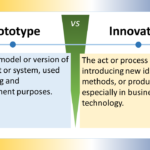The difference between innovation and prototype involves the distinction between a process and a tangible representation.
Innovation is the overarching process of developing new ideas, products, or methods, usually with the aim of improving efficiency, adding value, or creating solutions.
A prototype, however, is an early sample, model, or release of a product built to test a concept or process.

Definition
Innovation
Innovation refers to the creation, development, and implementation of a new product, process, or service, with the goal of improving efficiency, effectiveness, or competitive advantage.
- Characteristics of Innovation:
- Novelty: Introduces something new or significantly improved.
- Application: Has practical use and is implemented in a real-world scenario.
- Value Creation: Leads to enhanced performance or additional benefits.
Prototype
Prototype is an initial or preliminary version of a product, system, or process that is created to test and validate the design, functionality, and feasibility of the concept.
- Characteristics of Prototype:
- Experimentation: Used to explore the viability of a new idea.
- Iteration: Can be refined based on feedback and testing.
- Representation: Serves as a physical or digital model of the proposed final product.
More Synonyms on innovation, innovate and innovative
Innovation Terms

Innovation is considered as a driving force in progress.
It includes the introduction of novel ideas, methods, or products that bring positive change and advancement.
For more information about innovations, check our glossary
Relationship and Relevance
Prototypes are often a crucial step in the innovation process. They allow innovators to test and refine their ideas before full-scale production or implementation. While innovation encompasses the entire journey from conception to final product or service, a prototype is a tool used within that process to experiment, evaluate, and progress an idea.
Innovation
- Innovation is the broad process of creating something new that provides value, whether it is a new product, service, business model, or process.
- Innovation can range from incremental improvements to existing offerings to more radical, disruptive changes.
- Innovators work on developing new ideas and technologies that can lead to future disruptions.
Prototype
- A prototype is a tangible, early model or representation of a new product or idea.
- Prototypes are used to test new concepts, get feedback, and refine ideas before investing in full development.
- Prototypes help make ideas more concrete and understandable, allowing for exploration, experimentation, and learning.
- Prototyping is a critical part of the innovation process, as it allows innovators to quickly test and iterate on new concepts.
In summary, innovation is the overall process of creating something new, while a prototype is a specific tool used within that process. Prototypes allow innovators to bring their ideas to life in a tangible way, test them, and gather feedback before fully developing the final innovation. Prototyping is an essential part of the innovation journey, as it reduces risk and helps refine ideas.
The search results emphasize that prototypes are not the final innovation itself, but rather a means to an end in the innovation process.
Context for Using Each Term
- Innovation is used within the context of bringing new ideas to life and introducing them to the market or society, often discussed in business, technology, and science.
- Prototype is a term used in the design and development phase, where an example or model is built to test and refine the concept.
Example of Utilization
A tech startup that develops a new encryption algorithm for secure communication is engaging in innovation. When the startup creates an initial software version embodying this algorithm to test its functionality, this software version is the prototype.
In conclusion, while innovation is the broad process involving the conception and development of new ideas or methods, the prototype is a preliminary model created during this process to test and refine the innovative concept before it is finalized and launched.
FAQ
Q1: Is a prototype always part of the innovation process?
A1: While prototypes are common in many innovation processes, not all innovations require prototyping, especially in non-physical innovations like business models or services.
Q2: Can a prototype be innovative?
A2: Yes, the process of creating a prototype can lead to innovative solutions or features that weren't initially conceived.
Q3: How many prototypes are typically created during an innovation process?
A3: The number of prototypes can vary greatly depending on the complexity of the innovation and the development approach. Some innovations might require numerous iterations, while others might need only a few.
Q4: Can innovation occur without prototyping?
A4: Yes, especially in fields like theoretical science or conceptual innovations where physical models aren't necessary or possible.
Q5: Are prototypes always physical objects?
A5: No, prototypes can also be digital, such as software mock-ups, or even conceptual models in fields like service design.

